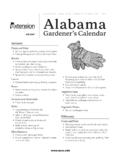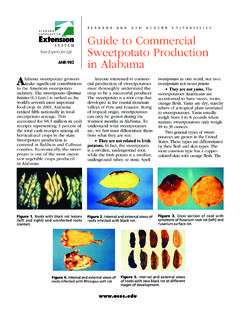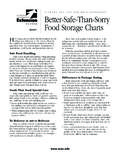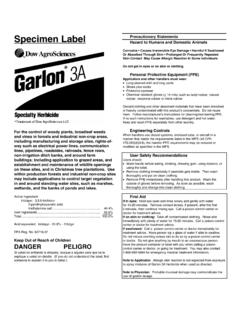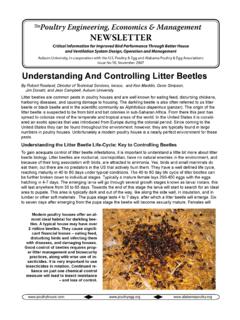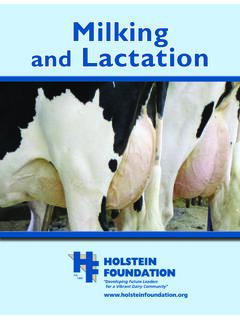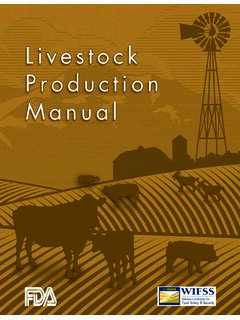Transcription of Goat Vaccination - Alabama Cooperative Extension System
1 Goat VaccinationLIVESTOCK The goal of Vaccination is to stimulate an immune response that provides some level of protection from disease. Unfortunately, most vaccines do not achieve complete protection from infection and subsequent disease. Vaccines are expected to reduce the severity of disease in infected animals or limit the frequency of disease in the factors, including nutrition, stresses, and the general health of animals, can influence the effectiveness of Vaccination . Vaccines should be administered according to label directions and only to systemically healthy animals. Consult your veterinarian for guidance when designing and implementing a herd Vaccination program. Vaccines should not be expected to eliminate all disease problems and should be considered only as a tool to be used with other management strategies to mitigate the occurrence and impacts of infectious of VaccinesKilled Vaccines Killed vaccines and toxoids consist of killed microorganisms, components of pathogens, or by-products of microorganisms in combination with adjuvants, such as aluminum hydroxide or oil, in order to produce a sufficient immune response.
2 The major advantages of killed vaccines are safety and stability of the product. Disadvantages include the need for multiple doses (booster Vaccination ) to produce a protective immune vaccines are a type of killed vaccine that contains only part of the virus or bacteria. These vaccines isolate the most important part of the microorganism needed to produce a proper immune response while eliminating other components of the microorganism. Autogenous bacterial vaccines (autogenous bacterins) are produced from bacteria isolated from samples collected from diseased animals. The bacteria are cultured, killed, and mixed with adjuvant. These vaccines frequently contain high levels of endotoxin and other by-products found in the culture and should be used with caution.
3 Advantages include the production of custom-made, herd-specific vaccines for which a commercially made vaccine might not be available. Modified Live VaccinesModified live vaccines (MLV) contain a small quantity of virus or bacteria that has been altered so that it no longer is capable of causing clinical disease. It is still capable of causing infection in the animal, which is necessary to produce an immune response, but warrants cautious use in some animals. For example, a MLV should not be administered to a pregnant doe that was never vaccinated prior to pregnancy. The immunity produced by MLV typically is longer in duration and more robust than the immunity produced by killed vaccines. Careful handling, mixing, and storage of MLV is critical.
4 Exposure to high temperatures, sunlight, freezing, soaps, or delayed administration from the time of mixing can result in damage to the vaccine. MLV products, once rehydrated with diluent, should be used within an hour of 1. most vaccines are administered subcutaneously (SQ, under the skin), which can be performed in a triangle of skin in front of the shoulder or in the axillary (under the arm) region. Intramuscular injections should be given only in the neck muscles, using the same injection Alabama Cooperative Extension SystemGoat Vaccinations 3 Vaccination Guidelines Examples of important small ruminant diseases for which vaccines are available: Clostridial enterotoxemia and tetanus Caseous lymphadenitis (CL) Foot rot Pneumonia (pasteurellosis) Infectious causes of abortion Clostridial Diseases Enterotoxemia and Tetanus The vaccine commonly known as CD&T is a Vaccination against Clostridium perfringens type C + D (enterotoxemia) and Clostridium tetani (tetanus).
5 Goats are extremely susceptible to enterotoxemia and it is generally held that Vaccination against clostridial disease is an absolute requirement and should be considered a core vaccine in all goats. Prevention of disease must include control of potential risk factors (for example, banding castration methods, abrupt changes in diet) and immunization against clostridial toxins. Vaccination must aim to protect adult animals as well as confer protection to kids through transfer of passive immunity (antibodies) in colostrum . Several commercial CD&T vaccines are available as well as other clostridial vaccines that protect against additional clostridial species. Consult your veterinarian to determine if other clostridial diseases are common in your area and herd to determine if protection beyond Clostridium perfringens C + D and tetanus is needed.
6 The 7- or 8-way cattle blackleg vaccines are not recommended for use in goats as tetanus is not typically included in these vaccines. Research suggests that the duration of protective immunity is much shorter in goats when compared to sheep and cattle using similar clostridial vaccines. Goats may need to be vaccinated at intervals of 3 to 4 months to maintain adequate protection against enterotoxemia using currently available clostridial vaccines. At a minimum, goats should be vaccinated annually and ideally semiannually (every 6 months) following an appropriate primary Vaccination schedule, especially if disease pressure or risk is considered to be high. Initial Vaccination must be followed by a booster 3 to 4 weeks later. Kids should be vaccinated initially at 6 or 8 weeks of age, with Vaccination occurring before weaning.
7 Booster vaccines should be administered to kids 3 to 6 weeks later, depending on product recommendations. Some experts recommend 3 doses administered 4 weeks apart as the primary series of vaccines in young kids. If a kid is born to an unvaccinated dam and, therefore, did not receive colostral antibodies against clostridial species, Vaccination of the kid should take place within the first 2 weeks of life. Protection against tetanus is imperative, especially in herds where banding castration of young kids is practiced. Does should be vaccinated against clostridial diseases approximately 30 days prior to kidding to ensure that adequate antibodies are produced and concentrated in colostrum , which provides protection in the kids. Replacement doelings and other purchases should receive a minimum of 2 doses prior to kidding.
8 Do not forget to vaccinate bucks and other replacements, especially those with unknown Vaccination LymphadenitisCaseous lymphadenitis, also known simply as CL, is caused by the bacterium Corynebacterium pseudotuberculosis, which results in the abscessation of lymph nodes. Goats typically have involvement of peripheral lymph nodes around the face (submandibular, parotid), but the disease can also affect internal lymph nodes, such as those associated with the lungs. This pathogen is zoonotic (can infect humans). When handling diseased goats, always wear protective clothing and against CL should be carried out under the guidance of a veterinarian, as there are several approaches to dealing with CL at the herd level. This is especially important in herds in which goats will be checked via serology (blood antibody titer) tests, as Vaccination will interfere with interpretation of titer results.
9 Vaccination does not prevent infection by the bacteria, but serves to lessen the severity of disease 2 Alabama Cooperative Extension SystemGoat Vaccinations 3and reduce the incidence of abscess formation. Vaccine types available for CL include bacterins, toxoid, combination products (bacterin + toxoid), and autogenous. A commercial vaccine labeled for use in sheep is available in the United States and has been used successfully in goats. However, it should be noted that another vaccine that contains Clostridium CD&T plus CL antigens produces a strong adverse reaction and is not recommended by the Federal Drug Administration for use in RotThe colloquial term foot rot, especially when applied to small ruminants, can be misleading as foot rot is not a simple one-bug, one-disease condition.
10 Rather, several forms of foot rot lesions can occur in small ruminants, and it is important that the correct disease process be diagnosed before pursuing Vaccination against infectious foot rot. Benign foot rot (also known as foot scald) is due to Fusobacterium necrophorum infection, whereas contagious virulent foot rot is due to bacterial infection by Dichelobacter nodosus. The former (F. necrophorum) is more akin to the foot rot found in cattle, whereas the latter (D. nodosus) is found most often in sheep and is highly contagious and can spread through flocks and herds causing lameness in multiple feet, in multiple animals. Commercial vaccines exist for both conditions. Vaccination against F. necrophorum is labeled for cattle use only; efficacy in goats has not been demonstrated and is considered extra-label use of the vaccine.
